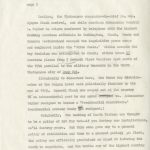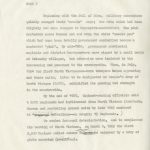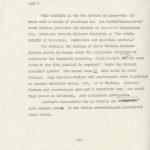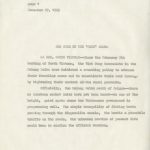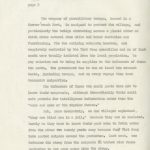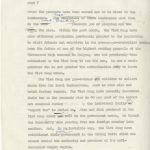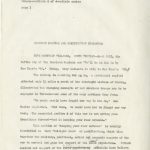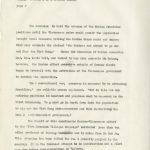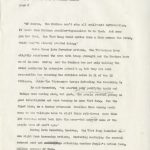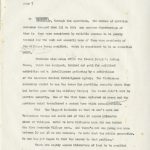1965, December 27, “America’s Inscrutable War”
Deepe 1965 wrapup
wrapup–article 1 of 4-article series
page 1
December 27, 1965 US. Strategy for News NY. H. T.
AMERICA’S INSCRUTABLE WAR.
PLEIKU, SOUTH VIET NAM–This was an ungainly place for history to be written.
During the steaming hotmid- morning hours, one February 7, Presidential advisor MacGeorge Bundy arrived in the silvery c-125 transport aircraft, “The White Whale” It is Uused by American commander General William C. Westmoreland, it’s the only airplane in the country withof wall-to-wall carpeting. Standing on the mortar-poxded steel airstrip, Bundy glanced at the billets where 116 Americans servicemen were wounded or killed, some of them in thier beds. The Viet Cong Communist guerrillas, in a lightning attack by suicide and mortar squads, had created a turmoil and destructive havoc in this small corps headquarters town (pop. 25,000) only 20 miles from the Cambodian border and not far from the finger-like road-lets comprising the Ho Chi Minh Trail.
Deepe
wrapup–article 1 of 4 article series
page 2
Earlier, the Vietnamese commander-in-chief Lt. Gen. Nguyen Khanh arrived, and while American Ambassador Maxwell D. Taylor in Saigon conferred by telephone with the highest ranking American officials in Washington, Khanh, Bundy and General Westmorland escaped the inquisitive press corps and conferred inside the “White Whale.” Within seconds the key decision was articulated to Khanh; within hours 49 American planes from 3 Seventh Fleet Carriers sped north of the 17th parallel to Bomb the military barracks in the North Vietnamese city of Dong Hoi.
(Ironically to observe here, the three key diecision-makes at the Saigon level were politically finished by the end of 1965. General Khanh was couped out of the country tofor an Ambassadorial post he was never assignedrecruited to. Ambassador Taylor resigned to become a “Presidential consultant.” Presidential Advisor Bundy had resigned.)
Originally, the bombing of North Vietnam was thought to be a policy of tit for tat–if you destroy our installations, we’ll destroy yours. But this soon gave way to a general policy of retaliation and then to a general policy, aAt first, the policy was officially proclaimed as aimed at inducing the North to negotiate, and the battle cry of the highest ranking American officials became “we’ll be at the conference table by September.”
Deepe
wrapup–article 1 of 4 article series
page 3
But Hanoi did not negotiate. Then the official line shifted to the military objective of hitting the military installations and routes of communication which allowed Hanoi to infiltrate men and material into South Vietnam. But, at year’s end, the official estimates of North Vietnamese infiltration into the South had more than doubled–to 2500 men a month.
Superficially, the policy of bombing North Vietnam failed to meet its political objective of forcing Hanoi to negotiate or its military objective of stopping infiltration. More accurately, the policy half-succeeded, for by year’s end, the bombing of the North had partially paralyzed the economic potentials and manpower reserves of the country. In short, if the bombings did not stop Hanoi‘s policy of aggression, in official eyes, it would They would at least make it more expensive and painful for North Vietnam to continue that policy. The policy of aerial escalation was also a little noticed policy of aerial expansion–Laos iswas also known to be subject to American bombing raids throughout the poast year; and by the beginning of 1966, the airwar threatened to spread to Cambodia, which would then engulf the whole Indo-China peninsula.
Deepe
wrapup–aticle 1 of 4 article series
page 4
The air war over North Vietnam, however, did not halt or abate the sharp deterioration of the ground war within South Vietnam, which had continued unimpeded since the fall of the Ngo Dinh Diem regime in November, 1963. The coup d’etat and resulting repercussions wredked the government’s administrative and intelligence apparatus; the impermoroneyimpermanency of a stable government at the Saigon level produced whirlwind changes of officials up and down the amdinistrative ladder. More significant,the strategic hamlet program formulated and nurtured by the Diem regime collapsed as the Viet Cong “conquered” each of the government hamlets, leaving behind their own guerrilla bands and political machinery as they advanced forward.
The gravity of the situation in the countryside could partially be measured by statistics. Before the fall of Diem in late 1963, the Saigon government claimed 8,000 strategic hamledts of the 12,000 hamlets in the countryside. By the end of 1965, the most optimistic “guess-timate” placed the number of “pacified” pro-government hamlets at 2,000. The government’s pacification plan for 1966 is known to call for pacifying those hamlets ina 6-mile radius fromaround the 43 provincial captials and a 3-mile radius ofaround the 250 district towns int he countryside.
Deepe
wrapup–article 1 of 4 atrticle series
page 5
Beginning with the fall of Diem, military commanders quickly changed their “measle” maps; the dots which had been slightly red were changed to Communist-controlled; the pink contested areas became red and even the white “measle pox” which had once been totally government controlled became a contested ‘pink’. By mid-1965, government provincial captials and district headquarters were ringed by a small oasis of friendly villagers, but otherwise were isolated by the increasing Red pressure in the countryside. Then, in July, 1964 the first North Vietnamese-born troopers began appearing and these units, later to be designated as People’s Army of North Vietnam (PAVN), solidified the growing Red strength in the countryside.
By the end of 1965, highest-ranking officials said 9 PAVN regiments had infiltrated from North Vietnam (American, Korean and Australian ground units by late 1965 numbered 44 “manower“maneuver” battalions–or roughly 15 Regiments.)
To combat internal deterioration, and to completment the bombing of North Vietnam, on March 8, 1965 the first 3,500 Marines rolled ashore only to be–and were welcomed by a bevy of girls carrying les of frangipangi.
Deepe
wrapup–article 1 of 4 article series
page 6
The American influx continued throughout the year–in “tranches” the French word for slice–a slice of the 3rd Marine Division, and finally the whole division; a slice of the 101st Airborne, a slice of the 1st Marine Division; the Republic of Korea tiger regiment and Marine Division; the Royal Australian Regiment; and finally the elite 1st Air Mobile Calvary Division, comprising 400-some helicopters and 15,000 troops, many of them airborne qualified. By years end the number of American combat military personnel numbered 100,000180,000; the outlook for 1966–the equivalent of at least one division a month for the next 12 months–or at least 200,00- more troops.
The first Marines were officially designated to provide “local-close-in security” for the Danag airbase; then the troops began “offensive patrolling for defensive patrollingpurposes,” but by mid-July, when the 173rd Airborne Bridgade launched a search-and-destroy operation in the Communit stronghold of D-Zone, the American troops for the first time since the Korean war were offensively and officially engaged with Communist elements.
Using the approach of gradualism, the policy of the employment of American troops, as well as the policy of bombing North Vietnam, was slowly escalated, expanded, stiffened and broadened until at the end of 1965 America had been eased into a war which it barely realized it had entered.
Deepe
wrapup–article 1 of 4 article series
page 7
On March 8, whith the arrival of the first American ground untis, units, the decade-old Cold WAr moved into a Lukewarm War, if not a Hot War. The idieological conflict, which had previously existed in diplomatic dispatches and conference table discussions, moved down to the swapps and jungles of South Vietnam; Vietnam became the focal point for the conflict of what was officially described as differing and conflicting ways of life.
But, more significant to observers here, it was a dramatization and crucial testing of two systems of power. One was the massive physical power of America; the other was the power of the Communists to manipulate the masses, to incite uprisings and deterioration of Anti-Communist strength in a war the Communists, more specifically, the Chinese Communists, labelled as the “war of liberation.” Both, Washington and Peking appeared to agree it was the “war of the future.”
The difference between these two implementations of power was well described by a 20-year-old American private who saw the building in Danang.
“I can tell you when Uncle Sam moves in, there’s no goofing around,” he explained, “There was nothing here; then the Marines moved in and the buildings started going up. We got are word a f-100 squadron was moving in here and we had 4 days to fill 200,000 bags of dirt for sandbagging of mortar defenses. Even the colonels were shoveling dirt.
Deepe
wrapup-article 1 of 4 article series
page 8
“Now you can look down this air runway and for two miles there are American jets wingtip to wingtip. That’s real power.”
But the privat, who had sat for 14 hours a day, for 13 months in a foxhole at the edge of the Danag runway explained the dichotomy of the war.
“The Viet Cong know more what’s happening on this airbase than the base commander and the 20,000 American Marines arond it. There are six thousand workers who come here daily–we know some of them are Viet Cong. If the Vietnamese security officer keeps them off, he and his family will be killed. The Viet Cong can come on this base right under our noses–we don’t know who’s who. We sa andold woman carrying a bucket of drain oil into the gate. When we checked her, there was only an inch of oil and the rest of the bucket was a false bottom filled with plastique. We captured one of the workers drawing all the defense structures on the base. We captured one of the drivers of an American bus taking down the tail numbers of all the American aircraft on the base. Once my unit was given five-hours of leave to go to the commissary. When we returned more than half of the 100 American foxholes around the base had a small paper bag in them. Each bag had a poisonous krait snake in it. Some worker had just walked around a dropped a snake in each foxhole.”
Deepe
wrapup-article 1 of 4 article series
page 9
This conflict in the two systems of power–the old woman with a bucket of plastique vs. the double-the-speed-of sound Phantom jets–was the essense of American’s Inscrutable War, which one Westerm diplomat described as “the unholy trinity of terrorsm, subversion and guerrilla warfare.”
The February 7th bombing of North Vietnam produced jittery nerves in Saigon where the population attempted to anticipate the Communist reaction. Would Hanoi‘s MICMIG-19s bomb south of the 17th parallel in reprisal? Would the Chinese Communist invade? The answer came 87 days later in Santo Domingo, when American Marines and paratroopers were dispatched to prevent wholesale chaos. But, as in Vietnam, American Marines and paratroopers were not a substitute for, nor could they create an efficient, just indigenous government.
America’s Inscrutable War in Vietnam has brushrerldbrushfired into another areas of the volite, underdeveloped, uncommitted Third World.
-30-
Red Rule in the Pink
Deepe
wrapup-article 3 of 4 article series
page 1
December 27, 1965
RED RULE IN THE ‘PINK’ DELTA
SA DEC, SOUTH VIETNAM–Since the Februrary 7th bombing of North Vietnam, the Viet Cong Communists in the Mekong Delta have initiated a crunching policy to advance their frontline areas and to consolidate their rear areas, by tightening their control ofon the rural peasants.
Officially, the Mekong Delta south of Saigon–where no American combat units have yet been based–is one of the bright, quiet spots where the Vietnamese government is progressing well. The simple tranquility of fishing boats passing through the finger-like canals, the hectic a utomobile traffic on the roads, the unbroken routine of peasant life would been to confirm the official version.
Deepe
wrapup-article 3 of 4 article series
page 2
But, according to villagers, the Viet Cong have virtually siezed politiclaal control of this rich rice-bowl area of Vietnam. The process of seizing control is not one of violent, visible military battles, but is instead the invisible strangulation and isolation of government authority. It is an economic political, social and semi=military process of subversion which might be termed termite warfare. The limits of government authority has been squeyested into a small wing of villages around provincial and district capitals and but even those the main isolated triangular outposts along the main roads and canals, apparent government-controlled centers are now contested a “pink” areas on maps between the expanding “Red” areas and the government “white” hard-core areas.
For example, six miles from Sa Dec, the headquarters of the Vietnamese 9th Infantry Division, lies the village complex of Bien ThegNha-Man. Two of the three villages are in already controlled by the Communists. The third village named Tan Nhuam Dang is protected by one company of 100–plus-some paramilitary troops, plus platoons in two smaller outposts one and two miles away.
This is the story of the Nga Ba outpost, situated two miles from the company headquarters and the Ba Thien outpost of one platoon situated one mile from the company headquarters.
Deepe
wrapup-article 3 of 4 article series
page 3
The company of paramilitary troops, housed in a former French fort, is assigned to protect the village, and particularly the bridge stretching across a placid river on which sides several rice mills and brick factories are fuctioning. The two outlying outposts however, are completely encircles by the Viet Cong guerrillas and as of last month were totally isolated from the local population. To pay salaries and to bring in supplies to the defenders of these two posts, the government has to use at least ten armored boats, including troops, and on every voyage they draw Communist sniperfire.
The defenders of these two small posts dare not to leave their compounds, although theoretically their small unit patrols for intelligence information makes them the “ears and eyes of the regular forces.”
But, more accurately, as one villager explained, “they are blind men in a jail,” because they are so isolated. Rarely do they dare to leave their post even to fetch water from the river two twenty yards away because they Viet Cong have posted snipers around the perimeter. Last week, one defender did stray from the outposts is barbed wire fence perimeter to get som ewater from the river.
Deepe
wrapup-article 3 of 4 article series
page 4
He was wounded by sniperfire on the bank of the river. None of his fellow defenders dared to rescue him. After three days, he diedHe later died and his body was [laid?] in the same spot [after?] three days. The post commander asked his higher headquarters for troop reinforcemoments to pick up the body that was twenty yards away from his own post. This request was refused. The defendders of the post were ordered to bury the corpse inside the post itself. The defenders again refused to pick up the body. Again, they were ordered to bury the body. The second time, they obeyed the order, but since their outpost lacked shovels they used their knives to dig the grave and since they lacked lumber and nails they used their knives to rip off the wood from the walls of their outpost to make the coffin.
Following the grotesque burial, the morale of the defenders of the outpost was so low that the company commander decided to rotate them. But the 100-,am company ordered to 90 ia relieve the platoon refused to accept the commander’s order and the majority of the troops defected, leaving behind their weapons, rather than be assigned to the NhNga Ba outpost. The province chief and the district chief were forced to visit the company and persuaded the deserters return to the government ranks–but the order to shift to the outpost was rescinded.
Deepe
wrapup-article 3 of 4 article series
page 5
Last month, the Viet Cong ordered the peasants and local businessmen working and living within a half-mile radius of the outpost to leave the area. Within this half-mile radius, none of the local villagers are allowed to liv or to move. Villagers have beenwere assigned small canals for their sampans rather than letting them move on the major river twenty yards from the outpost.
One of these moving out of this one-half mile radius was a rice mill owner, who moved his mill brick-by-brick and machine-by-machine to a location nearer government authority.
“The Viet Cong were very nice to give him the permission to move his rice mill,” one villager explained. “Otherwise, he would have starved to death,. No one would have brought theirHis rice to him to be polished since he was within the half-mile radius around the post.”
Since the bombing of North Vietnam, the Viet Cong Communists have taken drastic and strict measures against the population as they press forward with their policy of expansion and consolidation. In their monthly prpaganda meetings with the villagers, the Viet Cong cadre announces that “the Americans are waging an all-out war against the Vietnamese people. The people have to make a clear=cut choice between their friends and their enemies. Those who want to fight with the Americans can go to the government-controlled area.
Deepe
wrapup-article 3 of 4 article series
page 6
Those who want to fight against the Americans can stay with us. There is no third choice.”
The one exception was for thatthat for those families who have suffered from American bombing and strafing raids could flee to government-controlled territory–but they could not cooperated with the government.
Hence, in this Sa-Dec division headquarters town, the refugee villagers haveprefer to lived in their sampans and live parked along the riverfront. But they have refused to live in the refugee housing provided by the government.
Many of the wealtheiier landowners have already been forced to flee the government-controlled zones, which has given the Communists the effect of an economic purge of the area. The vacaded lands of the landowners, especially the fruit groves along canals, has been systematically boobytrapped and mined by the guerilla forces.
Now, the Viet Cong have told the large and the small landowners that their land will be confiscated if they allow their children to become government soldiers. The few wealthy landowneres who remain in the area have been warned they will not be allowed to hire peasants to help till the land.
Deepe
wrapup-article 3 of 4 article series
page 7
–And the peasants have been warned not to be hired to the landowners. The wealthiest of thosethese landowners must then do the workback-Breaking peasants job of planting and how stingHarvesting the rice. Within the past month, the Viet Cong have also withdrawn permission previously granted to the population to visit friends and relatives in the government-controlled areas. Even the father of one of the highest ranking generals at the Vietnamese high command in Saigon, who had previously been authorized by the Viet Cong to see his son, is now a semi-prisoner who is not granted the authorization ship to leave the Viet Cong atreas.
The Viet Cong use pre-teenage and children to collect taxes from the local businessmen, such as rice mill and brick factory owners. The Viet Cong have recently increased their tax on the peasants rice for 40 per cent of the amount not consumed during the year by the individual family. anAn “export tax” is levied on., Rrice and fish produced in the Viet Cong areas not sold–And in the government areas, as though the foodstauffs were passing from one foreign country into another. And, in onan invisible way, the Viet Cong have established their own government in the Mekong Delta which has almost eroded the authority and presence of the anti-Communist Saigon regime.
###
(Tomorrow: American Marine and Pacification headaches.)
American Marines and Pacification Headaches
This fourth wrap-up article explains how the Americans’ issue was not in struggling to advance militarily, but in preserving the ground they’d already covered. In this war, there was not only a frontline to worry about, but a width and depth of which the Communists had a much better understanding.
deepe
wrapup-article 4 of 4 article series
page 1
AMERICAN MARINES AND PACIFICATION HEADACHES
FIVE MOUNTAIN VILLAGES, SOUTH VIETNAM–Last fall, the battle cry of the American Marines was “We’ll be in Hoi An by New Year’s ’66.” Today, they estimate it will be New Year’s ’68.‘
The hold-up in reaching Hoi an An, a provincial capital situated only 15 miles x south of the strategic airbase of Danang, illustrates the changing concepts of how American troops are to be employed in Vietnam–and some of the many problems they face.
“We could easily have fought our way to Hoi An,” one Marine explained. “But then, we would have had to fought our way back. The essential problem i of this war is not moving your frontlines forward–but is keeping your rear covered.”
This problem of “keeping your rear covered” is usually identified as that “twilight area” of pacification, which ties together the military, political, social and economic aspects of the war to control and gain the support of the localrural population. Without control and support of the rural populationvillagers, officials here believe the war could continue for years.
deepe
wrapup-article 4 of 4 article series
page 2
The decision to halt the advance of the Marine frontline positions until the Vietnamese cadre could pacify the population brought vocal dissents withing the Marine Corps ranks and sneers from Army colonels who claimed “the Marines are afraid to go out and find the Viet Cong.” Under thx direction of Marine commander Maj. Gen. Lewis Walt, and backed by key Army generals in Saigon, however, the Marine effort outisde o outside of Danang slowly began to dovetail with the activities of the Vietnamese government to control the population.
“In a conventional war, progress is measured by an advancing frontline,” one reliable source explained. “But in this war our outlying positions isare constant and progress must be measured in the third dimension. We g must go in depth down into the population to dig out the Viet Cong infrastructure and then re-building the loca l anti-Communist government.”
The result of this coordinated Marine-Vietnamese effort is the “Five Mountain Villages Campaign” initiated less than ten miles southwest of Danang., but evenm and 15 miles from Ha Hoi An. This campaign has been tabbed the No. 1 priority project inth cuntry; it is the foremost attempt in in pacification and a pilot case for future decision-making in Vietnam.
deepe
wrapup-article 4 of 4 article series
page 3
Secretary of Defense Robert McNamara was briefed in depth on the project during his last visit.
“If this plan doesn’t succeed here, it’s not going to succeed anywhere else in the country,” one reliable source explained. “We’ll really be in serious trouble then.”
The project has already run into some serious trouble.
“Now we’re just spinning our wheels,” one source explained.
The “Five Mountain Villages” campaign callsed for the pacification of five villages (subdivided into 19 villagesHamlets), covering a twenty square kilometer area. The five-village complex comprisescontains 42,000 population–of which about seven percen tof the families are considered to be related to the Viet Cong Communists. The villages, densely populated villages, snuggled in lush rice paddy, isare surrounded by the peaksm ofmm five peaks of mountains containing grey and salmon-colored marble. (“These Marble Mountains would make a great tourist attraction, but you’d be killed going out there,” one Marine cracked.).
deepe
wrapup-article 4 of 4 article series
page 4
The plan callsed for three components for pacification–the American Marines who secure the outer perimeter of the area by myriads of patrols to prevent the invasion of hard-core Communist units, the Vietnamese paramilitary troops who secure the r villages, and the Vietnamese civilian cadre who through distribution of economic goods, psychological warfare, census-taking and organizing the people attempt to weed out the Viet Cong infrastructure and convince the villagers to side with the anti-Commnist government forces.
“The role of the American Marines is mreliablemrmsourcemhexlimm like an egg,” one reliable source explained. “Our frontlines on the rim of the area is the shell–but like a shell, the lines can be broken. The vital installation–the Danang airbase–is the yok yok yolk and we also defend that. The white is what we are trying to pacify and then solidify.”
On October 18, the Vietnamese government, with Marines on the Mekong forces, began their pacification in the rear by using one headquarters company and onne four understrength line companies of the 59th Regional Forces Battalion to sweep through the area. Then 327 civilian cadre were moved in from the provincial headquarters and the Vietnamese commander put them through a detailed two-week re-training course. Then the commander recieved five Vietnamese Peoe People’s Action Teams (PAT’s), totalling 50 persons, who were responsible for census taking and other activities.
deepe
wrapup-article 4 of 4 article series
page 5
In each of the five villages, the Vietnamese commander placed and Regional Forces company and one People’s Action Team; in each of the 19 hamlets, he placed a civilian cadre team.
“But during the third week of the campaing, a 50-man Viet Cong platoon broke through the Marine blocking position and were in t our area shooting things us up and they hit us hard,” one reliable source explained. “Five regional force troopers and several cadremen were killed. Since each of our armed companies was 42 per cent understrength, we had 15-man platoons in when we should have had 35 men. And fighting against 50 Viet Cong, of course, we lose against those odds. Until that we were just beginning to get the confidence of the people–but after that, the people clammed up and wouldn’t tell us anything. And it also hurt the morale of our cadre. One whole 11-man team took off–but the district chief talked them into coming back.
“Then four nights later, the same Viet Cong platoon hit us again. They slipped in between two Marine patrols, attacked the Regional Force headquarters unit of 17 men, killed seeral civilian cadre and kidnapped two of the women working with the drama unit. We haven’t seen the women since. One of the American Marines saw the whole action from 50 yards away–but he couldn’t open up with his machinegun. He would have killed more friendlies than enemy.
deepe
wrapup-article 4 of 4 article series
page 6
“Of course, the Marines can’t stop all small-unit infiltration. It would take Marines shoulder-to-shoulder to do that. And once you had that, the Viet Cong would mortar them a from across the river, which they’ve already started doing.”
Sinc e these late November actions, the Vietnamese have slightly reinforced the area with troop strength and the Marines have moved in more units; now the Marines are not only holding the outer peremiter by extensive patrolling, but they are also responsible for securing the civilian cadre in 11 of the 19 villages, whilewith the Vietnamese troops defending the remaining 8.
By mid-December, “we started pacy pacifying again and things were moving slow, but good.” the source continued. “The people started giving us good intelligence and were turning in some Viet Cong. For the first time, on a Sunday afternoon families from Danang would come to the villages here to visit their relatives; more than 100 families moved back into the area–but noen of none of the people were of draft age.”
During late December, however, the Viet Cong launched onon one night four harassing actions, including mortaring the central command post and omoxouring attackng another People’s Action Team, killing several of them.
deepe
wrapup-article 4 of 4 article series
page 7
/r Gradulal
Gradually, through the operation, the number of civilian cadremen dropped from 331 to 304; one serious disadvantage of them is they were considered by reliable sources to be poorly trained for the[their?] work and secondly none of them were residents of the villages bein pacified, which is considered to be an essential pointprerequisite.
Problems also arose aboutwith the 10-man People’s Action Teams, which are equipped, trained and paid for political activities and a intelligence gathering by a subdivision of the American Central Intelligence Agency. The Vietnamese commander wanted to use the teams for providing security since they had better guns than his military troops; the teams didn’t want to provide security. One of the five teams defected en masse and the province chief transferred a second team which causedproblems. trouble.
“But the biggest headache is that we can’t move our Vietnamese troops and cadre out of this 20 square kilometer chunk of villages until we have villagers here who can defend the Five Mountain Village area. And there’s not one young man here between 10 and 38 we can recruit. We have lost the middle generation. No one has yet begun to find the answer to that problem.”
There are eighty square kilometers of land to be pacified before reachiing Hoi An. And that’s why the present official estimate is Hoi An will be reached by New Year’s, 1968.
-30-
Read Previous Article: 1965, July 8, “American Jet Aircraft”


